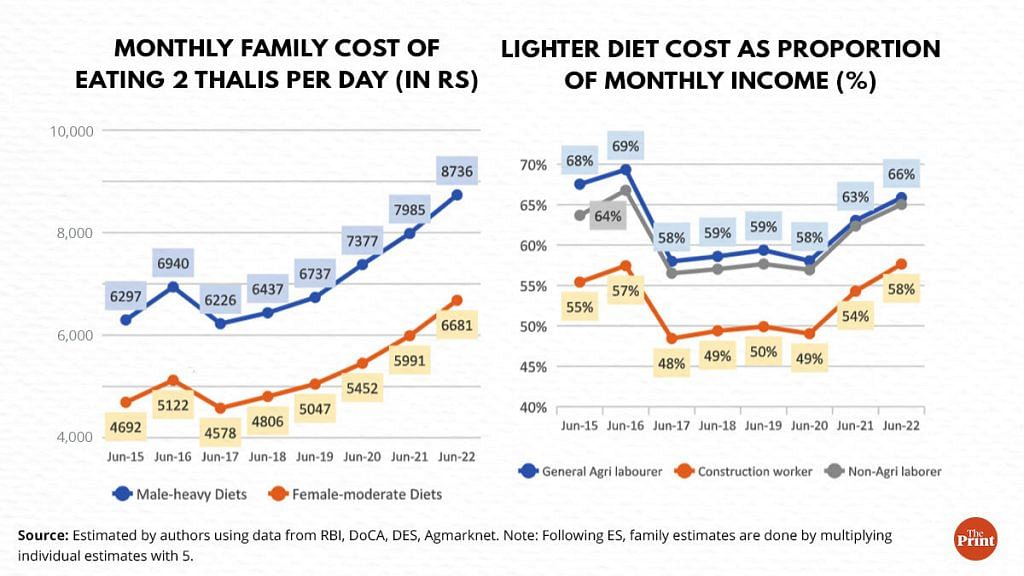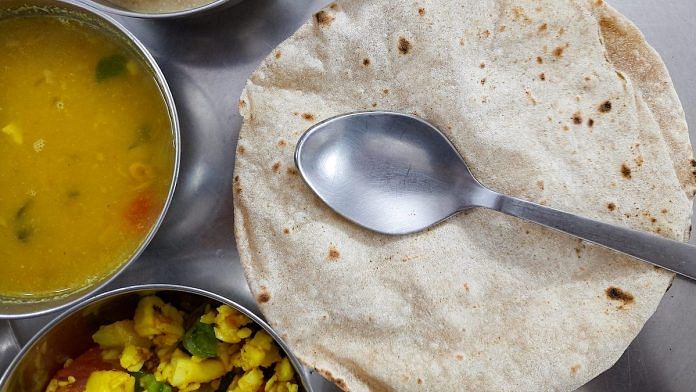Inflation, particularly food inflation, has been centre stage not just in India but globally. Despite moderation observed in India’s June 2022 inflation print, food inflation continues to stay in the uncomfortable zone of 6 to 8 per cent since the start of the year. How does this high food inflation impact an average Indian? We use a simple metric to estimate this: How much does it cost an average Indian to have one homemade thali of food?
This concept of thali cost builds on the ‘Thalinomics’ chapter from the Economic Survey (ES) of 2019-20. Then-CEA Dr Krishnamurthy Subramanian estimated the price of a thali for an average Indian. We use the same concept and bring to you its current estimates.
Constructing a thali
Following the Economic Survey, we define a typical vegetarian thali as per the National Institute of Nutrition (NIN) 2011 guidelines. According to which, a thali that an average Indian should be consuming consists of: cereals (rice and wheat), vegetables (potato, onion, tomato as staple veggies, and brinjal, cabbage, lady finger and cauliflower as seasonal veggies), pulses (gram, arhar, masur, mung and urad), spices (turmeric, dry chillies, salt and coriander) and vegetable oils (mustard, coconut and groundnut). In addition to the cost of these items, a thali price includes the cost of fuel for cooking.
To meet daily nutritional requirements, an individual should consume two such thalis.
By combining these thali components with their retail prices, the Economic Survey estimated the cost of a homemade thali.
We replicate this method, with a few exceptions.
For example, for the data on retail prices, while the ES uses CPI-industrial workers (April 2006 to October 2019), we used data from the government’s Department of Consumer Affairs (DOCA) and Department of Economics & Statistics (DES).
ES estimates costs for both vegetarian and non-vegetarian thalis, but we present estimates of a vegetarian thali only.
Furthermore, ES takes the dietary requirements of an adult male undertaking heavy work (heavier diet) and multiplies it by five to represent the family’s diet. We think this diet is on the higher side as multiplying a male heavy worker’s diet by five amounts to overestimation. Therefore, our estimates are presented for both adult male (heavier) diets and female moderate worker (lighter) diets.
We next present the daily cost of food (two thalis) incurred by an average Indian. We present estimates for the month of June every year since 2015.
Also read: Inflation pinching your pocket? There is more in the pipeline. But god can help
Cost of an Indian homemade thali
In June 2015, one vegetarian thali (lighter diet) cost a little less than Rs 16 (that is, about Rs 31 for two thalis a day). The same diet, in June 2022, cost Rs 22 (or Rs 45 per day). This implies that the cost of one thali jumped up cumulatively by about 42 per cent.
In the case of heavier diets, the increase is about 39 per cent: from Rs 21 per thali in June 2015 to Rs 29 per thali in June 2022.
For a family of five, this implies that the monthly thali costs jumped up from about Rs 4,700 (2015) to about Rs 6,700 (2022) for a lighter diet and from about Rs 6,300 to Rs 8,700 for a heavier diet (LHS Figure 1).
Figure 1

In terms of thali components, most price pressures in June 2022 appear to be coming from cooking fuel costs, followed by edible oils, and vegetables.
Caution is important here: Given the enormous diversity in diets across India, this thali and its cost are only representative. In addition, this thali is constructed based on NIN guidelines and only reflects what an individual should be consuming and this is likely to differ from individual to individual and from what they actually consume.
Also read: Food worries mount for India, as erratic monsoon rains cause 13% lag in area under paddy
Pressure on consumer budgets
To assess the impact of higher thali costs on consumer budgets, we took daily wage rates of the following rural labourers: (i) general agricultural labourers; (ii) construction workers; (iii) non-agricultural labourers (including porters, loaders) since June 2015.
If only one member of a family of five earned on all days in a month, then for lighter dietary requirements, in June 2017, 48 per cent of the monthly income of a construction worker would have been used for feeding two thalis to each member every day. In June 2022, maintaining the same diet would have required close to 60 per cent of their monthly incomes (RHS Figure 1).
We need to remember that these thalis do not account for items such as fruits, milk, curd, tea, coffee, and animal proteins like eggs, meat and fish because it is a vegetarian thali. Adding these items would push up the cost of thali because many of these items recorded high inflation since early 2020.
What these estimates mean
-Nutrition of the poor will worsen: With rising food prices, the poor are likely to reduce consumption (or replace expensive but essential food items like fruits, and vegetables with cheaper alternatives), adversely impacting their nutrition.
-Impact on other expenditure heads: With a greater proportion of family incomes being utilised for buying food, poor families will have to cut corners and the axe may fall on important expenditure heads such as children’s education and family health.
-Poverty is likely to worsen: During the 2011 global food price spike, ADB (2011) found that a 30 per cent increase in global food prices pulled up domestic food inflation in developing countries in Asia by 10 per cent, pushing an additional 64 million people into the poverty trap. For many Indians who suffered job losses, higher food prices are a double whammy.
There is no doubt that additional allocations of free rations under PM Garib Kalyan Anna Yojana (PMGKAY) from the start of the covid pandemic (April 2020 to September 2022) would have offered succour to the poor. However, continuity of these additional allocations appears unlikely post-September 2022 due to a shortfall in wheat procurement and a strong likelihood of a smaller rice crop in Kharif 2022.
The Reserve Bank of India in its August 2022 MPC meeting shared its assessment that food prices having peaked and will moderate in the coming months. However, upside risk may still come from: Global geopolitical tensions, the impact of GST on packed wheat flour, rice and other food items, shortfall of wheat towards October and November, and inter alia, extremities of Indian monsoons lowering yields and putting pressures on crops like paddy, tur (pigeon pea), tomato and onions, among others.
The Indian government needs more empathetic and agile policymaking. To begin with, it may rethink the release of FCI rice towards ethanol production. While attaining targets under the National Biofuel Policy (NBP) is critical, ensuring domestic food security, particularly in times of uncertain production, should take policy precedence. With prudence and foresight, the government has to more strategically balance interests of the poor and food insecure on one hand and farmers on the other.
Saini is an agriculture economist and the CEO and Co-Promoter and Khatri is Consultant, Arcus Policy Research. Views are personal.



